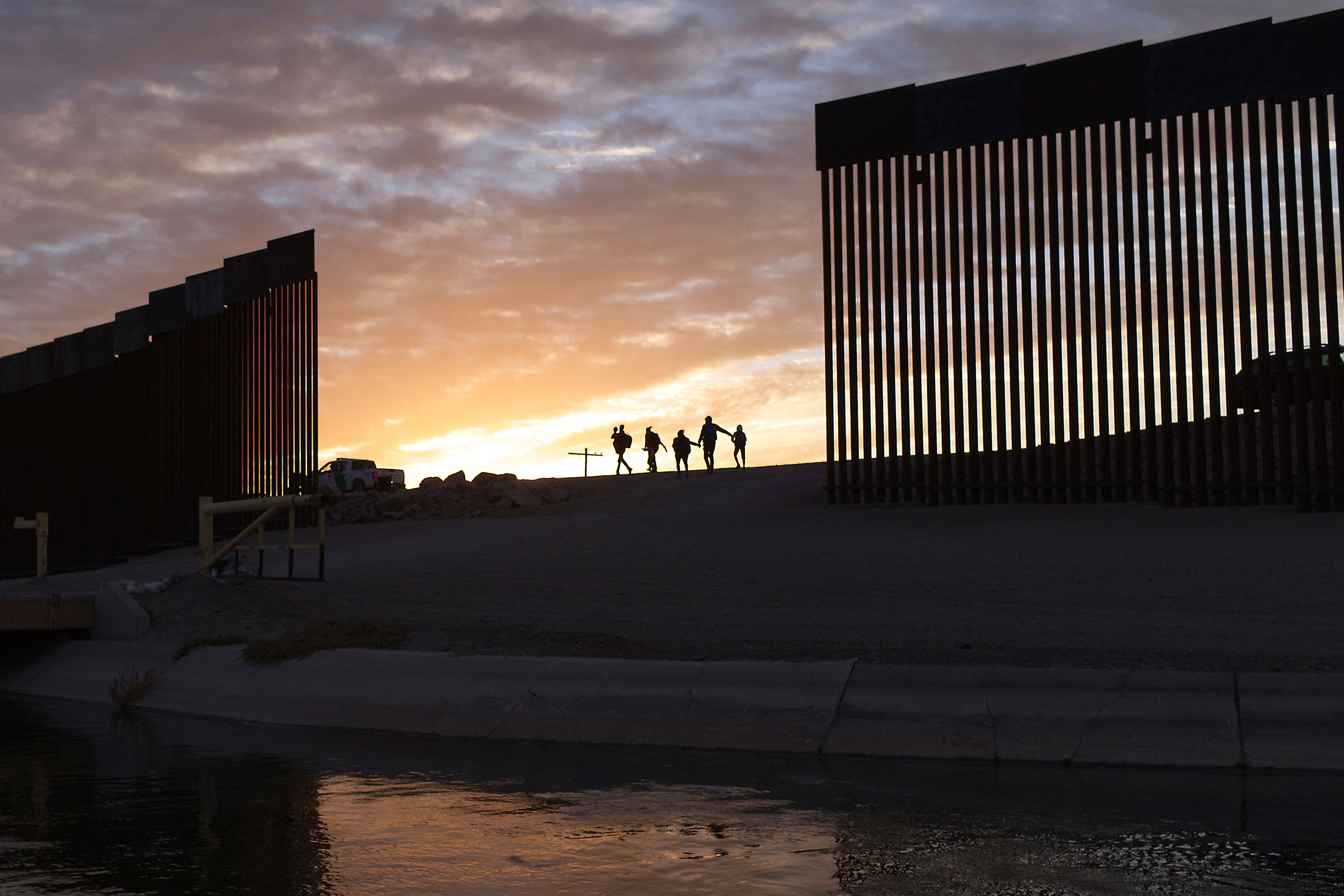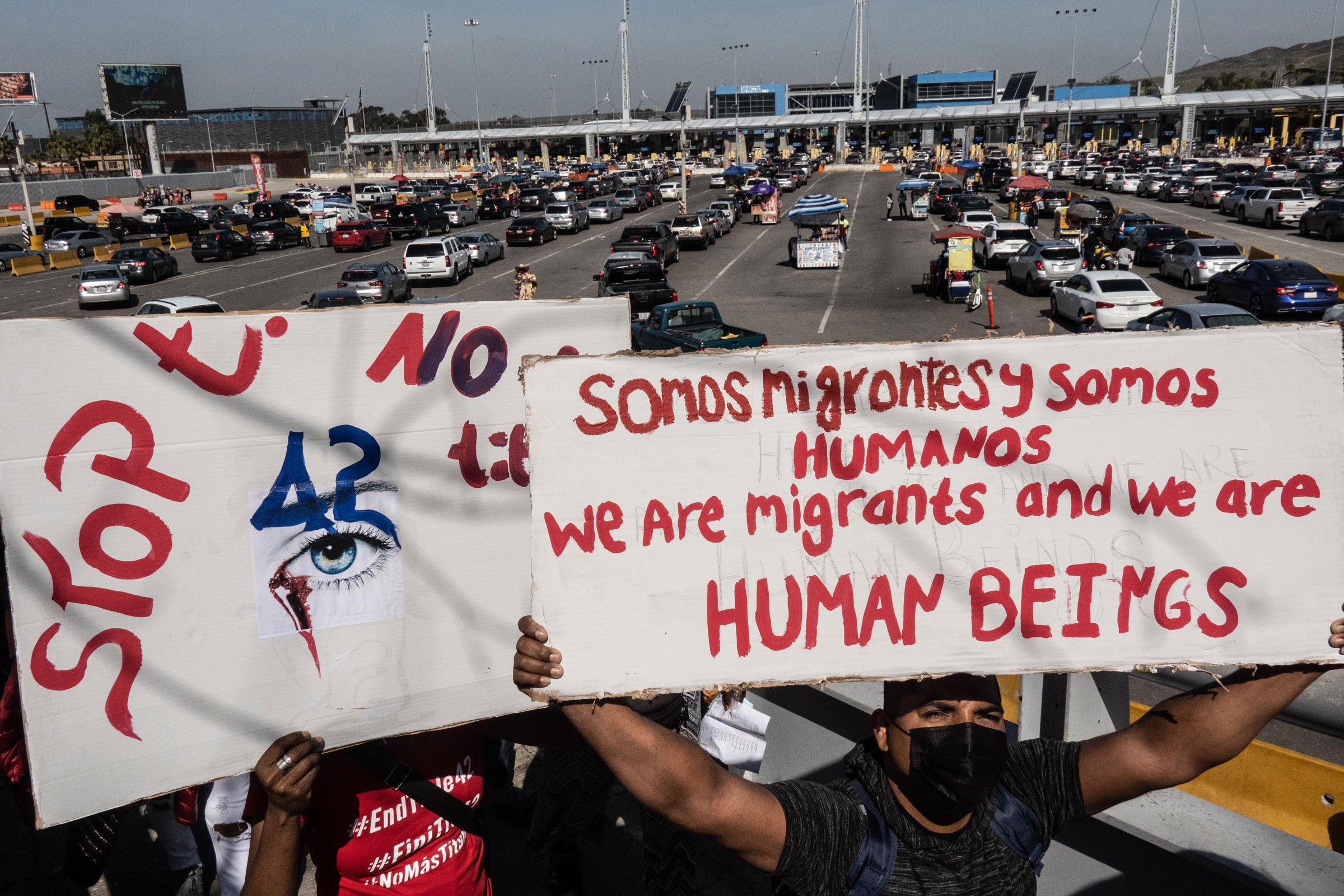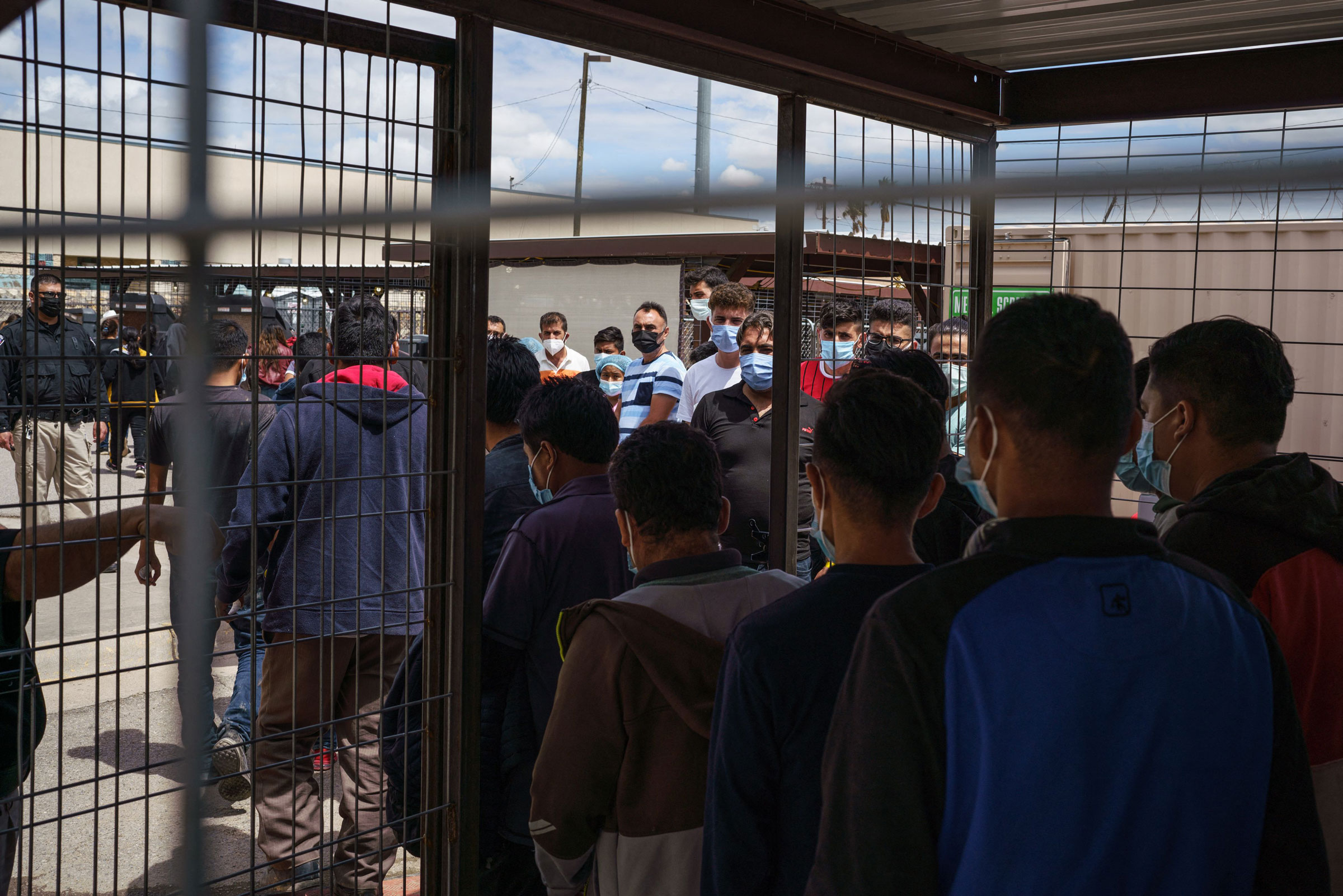
It was a warm evening in August when Keren, a 34-year-old migrant woman from Honduras, noticed a seriously injured man running down the street in Nogales, Sonora, a city just across the U.S.-Mexico border from Arizona. He had been stabbed; the knife was still buried in the side of his abdomen, Keren remembers. He refused her help and told her to run away. She was in danger, he said.
The moment stuck with terrified Keren. She and her children had fled their hometown in Honduras and arrived in Nogales in June, hoping to seek asylum in the United States. Now, thanks to two Trump-era immigration policies, they—and thousands of others like them—are stranded in Mexico, where they face similar threats to their safety.
The first policy, the Migrant Protection Protocols (MPP)—sometimes known as the “remain in Mexico” policy—was enacted by former President Donald Trump in 2019 and requires all asylum seekers to wait in Mexico while a U.S. judge evaluates their asylum claim, a process that can take years. In 2020, Trump invoked the second policy: the health measure Title 42, which said that in light of the COVID-19 pandemic, the government can immediately expel anyone who attempts to make an unauthorized crossing into the U.S., including people seeking asylum. And while MPP allows people to file an asylum claim and wait for the answer in Mexico, Title 42 doesn’t allow people to file any sort of claim at all.
On the ground, both policies have similar effects on people like Keren, who was expelled under Title 42. Both policies have sent thousands of people who had hoped to seek refuge in the U.S. instead to notoriously dangerous cities across the border in Mexico. Yet in recent litigation, the Biden Administration has chosen to fight to end one policy and uphold the other—a position critics say is hypocritical and contradictory on its face.
The Biden Administration is attempting to end MPP, arguing in part that stopping the policy would help address the flow of migration “while holding true to our nation’s values,” according to court filings. Texas and Missouri have sued the Biden Administration for seeking to end the policy, and the U.S. Supreme Court will hear arguments on the issue on April 26.
At the same time, the Biden Administration has fiercely defended Title 42 in litigation brought by the American Civil Liberties Union (ACLU) and other groups challenging the policy. The government has argued that the public health concerns of letting migrants into the country due to the continued threat of COVID-19 outweigh the possible harms done to migrants who are returned to crime-ridden Mexican cities like Nogales, Ciudad Juárez, or Tijuana. On March 4, the D.C. Circuit ruled that while DHS could continue expelling families under the policy, they couldn’t send them to countries where they’d face fear of persecution or torture. The Biden Administration hasn’t said if it plans to appeal the ruling to the Supreme Court. The U.S. Centers for Disease Control and Prevention (CDC) could also weigh in on the future of the policy when it conducts a review at the end of the month.
The Biden Administration has “simultaneously acknowledged the extreme humanitarian concerns that are caused by sending people back to Mexico, while also fighting bitterly to hold on to what they view as the most important tool at preventing people from crossing the border, which is Title 42,” says Aaron Reichlin-Melnick, senior policy counsel at the American Immigration Council, which filed a brief supporting the government’s request to end MPP before the Supreme Court. “This shows the whiplash between attempts to restore humanitarian protections at the border and an attempt to manage the border through deterrence.”

The two cases hinge on separate statutory questions—so legally, they don’t contradict. But logically, they do, says Ingrid Eagly, professor of law at the University of California, Los Angeles. The government is asking to use its authority to end MPP in part due to its “unjustifiable human costs,” yet it is asking in separate litigation to continue expelling all asylum seekers in the name of preventing the spread of COVID-19. What the positions have in common, Eagly says, is the government is arguing for broad discretion to decide how it handles the U.S.-Mexico border. “[The Administration] wants to be able to end the Trump-era MPP program if it sees fit,” Eagly says, “but also to continue Title 42 at its own discretion.”
Even a federal judge has noted the logical inconsistency as the two cases work their way through the court system. During a January hearing on the ACLU’s lawsuit against Title 42, D.C. Circuit Judge Justin Walker asked the Department of Justice (DOJ) if he should consider “the self-contradiction” between DOJ’s defense of Title 42 and DOJ’s filings before the Supreme Court saying MPP doesn’t align with the Administration’s values. Sharon Swingle, a lawyer representing the government, responded she doesn’t believe there is a contradiction, and that the government does not contest that migrants have “been subject to extremely harrowing conditions in Mexico or elsewhere.” She said that “the government’s goal is to get back to a state of orderly immigration processing for everyone,” but that “currently, in CDC’s view, the public health realities don’t permit that.”
The White House referred TIME to DOJ for comment on the Administration’s positions in these cases. DOJ declined to comment on the record.
The final outcome of both cases could determine how the Administration manages its immigration policy going forward, as it weighs differentiating itself from the Trump Administration with mitigating political backlash from Republicans and trying to slow the spread of COVID-19. Meanwhile, thousands of people remain stranded in dangerous conditions in Mexico with no resolution in sight.
A short time after Keren encountered the wounded man in Nogales, another man, who identified himself as a member of the mafia, pounded on the door of the small, wooden house she rented for her family. The man, visibly enraged, accused Keren’s 16-year-old son of having a sexual relationship with the man’s girlfriend. “He warned us that he won’t allow it and that he will look for accountability,” Keren, who TIME is only referring to by her first name because she fears for her safety if she is identified in Nogales, says in Spanish. She scrambled to find a new place for her and her children to live.
“[Nogales] scares me,” she says. “It was the same in my country, and now I’m here living through the same.”
‘It’s all coming to a head’
Joe Biden entered the White House vowing to end MPP, distancing himself from Donald Trump’s hardline immigration stance and promising a more empathetic approach to border control. But with the COVID-19 pandemic still causing an urgent public health crisis as his presidency began—and Republicans accusing Biden of being weak on immigration policy—inconsistencies quickly emerged in how his Administration dealt with the influx of migrants at the southern border.
On Jan. 20, 2021, Biden’s DHS announced it would no longer enroll anyone in MPP, and the following month began allowing those who had previously been placed in the program to enter the U.S. By May of 2021, more than 10,000 people of the roughly 71,000 enrolled in MPP had been processed into the U.S. “MPP had endemic flaws, imposed unjustifiable human costs, pulled resources and personnel away from other priority efforts, and did not address the root causes of irregular migration,” Department of Homeland Security Secretary Alejandro Mayorkas wrote in an October memo. “MPP not only undercuts the Administration’s ability to implement critically needed and foundational changes to the immigration system, it fails to provide the fair process and humanitarian protections that individuals deserve under the law.”
Yet the Administration continued enforcing Title 42 against adults and families, arguing it was executing the CDC’s order to “to safeguard the American public and the migrants themselves.” (The Biden Administration announced at the start of its term that it would no longer formally expel unaccompanied minors under Title 42.) Title 42 enforcement has led to tent encampments forming in Tijuana, across the border from San Diego, and Reynosa, across the border from McAllen, Texas.
Read more: Biden Is Expelling Migrants On COVID-19 Grounds, But Health Experts Say That’s All Wrong

Tamar, a 38-year-old migrant from Honduras, tells TIME she arrived in Tijuana in April 2021 with her three young daughters. She says she hoped to claim asylum in the U.S. because she was being extorted by gang members in Honduras, and to reunite with her husband, who’d migrated to the U.S. on foot and now lives in Florida. On their first attempt to cross the border, she and the girls were separated in a moment of panic when they came upon U.S. Border Patrol Agents, she says. Tamar and her youngest daughter, now six, hid in a bush, while her other two daughters, now nine and seven, ran in an opposite direction. The two older girls were picked up by border agents and processed as unaccompanied minors; after a month in custody, they were reunited with their father in Florida. Tamar and her youngest daughter, who eventually turned themselves into U.S. Customs and Border Patrol (CBP) and asked to claim asylum, were instead expelled under Title 42 back to Mexico, where they’ve now lived in a shelter for nearly a year, unable to file a claim for asylum.
“To know that my girls are over there and me over here…with me so close to the border,” Tamar, who is identified by her middle name because she fears for her safety and the safety of her family left behind in Honduras, tells TIME in Spanish. “One doesn’t have peace.”
With the incongruent policy positions came disputes from both sides; the Biden Administration had to defend its positions on both policies in court within the first year of Biden’s presidency. “I think if you’re coming new to these issues, you don’t realize just how unprecedented and extreme it is for the U.S. to prevent asylum seekers from either applying for asylum totally—which is Title 42—or forcing them to remain in another country even if they are permitted to apply… which [MPP] does,” says Karen Musalo, professor of international law at the University of California, Hastings. Muslao is also the director of the Center for Gender and Refugee Studies, a plaintiff in the lawsuit against Title 42.
In August 2021, the Biden Administration began defending Title 42 in court in the lawsuit brought by the ACLU. On March 4, 2022, the Administration was dealt a major blow, when the D.C. Circuit Court ruled that while the government could continue enforcing the policy, it could not return families to a country where they faced fear of persecution or torture. The government has not yet announced whether it plans to appeal the ruling, stick with the court’s decision, or end Title 42 entirely. Separately, as it does every 60 days, the CDC will also review whether to renew Title 42 on March 30.
Yet throughout that same time period, the Biden Administration was fighting to end MPP in separation litigation. On June 1, 2021, Mayorkas issued an order officially ending the program. Texas and Missouri sued, saying DHS didn’t have the authority to end the program the way it did. A district court and appeals court both agreed with the states, requiring DHS to reinstate MPP. The Supreme Court will make the ultimate decision by this summer.
The final results of both legal battles could determine the fate of thousands of migrants stranded in Mexico. “It’s all coming to a head in these next few weeks, potentially,” says Lee Gelernt, deputy director of the ACLU’s Immigrants’ Rights Project and lead attorney for the Title 42 case.

As these policies remain tied up in court, migrants now living in northern Mexico—either because of Title 42 or MPP—continue to face extraordinary violence. According to Human Rights First, an advocacy and research organization, there have been at least 9,800 reported cases of sexual assault, kidnapping, torture and other violent attacks on migrants who have been expelled under Title 42 since the start of the Biden Administration. A TIME analysis of CBP data shows that since February 2021, the Biden Administration has conducted more than 1.2 million Title 42 expulsions at the U.S.-Mexico border. Most of the people expelled were from Mexico, El Salvador, Honduras, and Guatemala. More than 1,500 people have been enrolled in MPP since the program was reinstated.
Keren, the woman from Honduras who is now stuck in Nogales, has channeled her fear and frustration into advocacy. On March 21, she joined a protest in Nogales calling for the end of Title 42. Similar protests took place in Tijuana, marking two years since the order was first invoked. “We have hope that we can successfully be heard and get the opportunity to be over there, to get our families out of danger,” Keren says. “There’s a hope, a possibility and a hope, that they’ll receive us.”
More Must-Reads from TIME
- Cybersecurity Experts Are Sounding the Alarm on DOGE
- Meet the 2025 Women of the Year
- The Harsh Truth About Disability Inclusion
- Why Do More Young Adults Have Cancer?
- Colman Domingo Leads With Radical Love
- How to Get Better at Doing Things Alone
- Michelle Zauner Stares Down the Darkness
Write to Jasmine Aguilera at jasmine.aguilera@time.com and Madeleine Carlisle at madeleine.carlisle@time.com